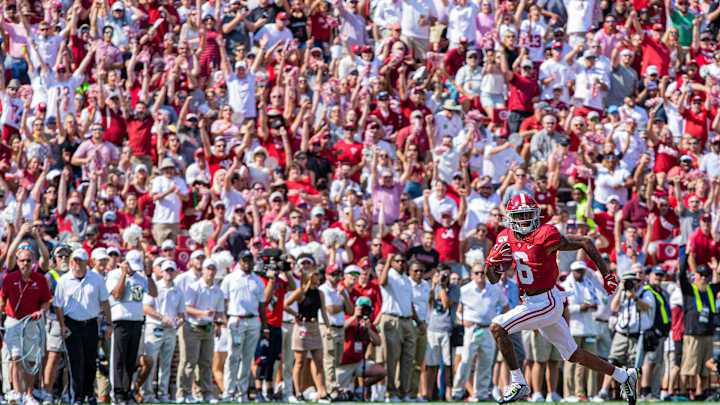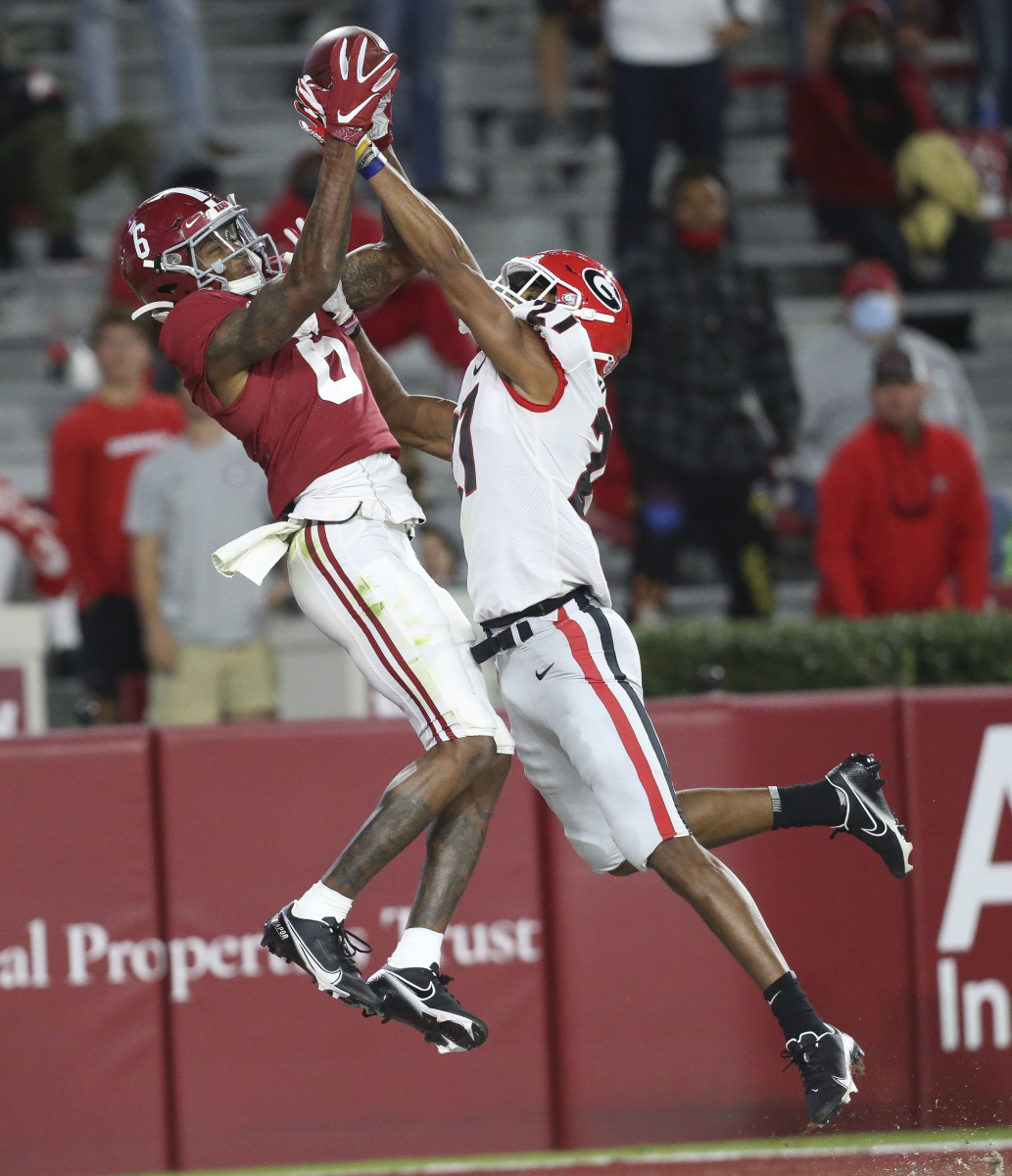Second-and-26? Wide Receiver DeVonta Smith has Grown Beyond Alabama's Most Famous Play

TUSCALOOSA, Ala. — Most college football fans hear the name and can immediately visualize the play.
Second-and-26.
It was arguably the biggest play in Alabama football history, and one of the most well-known in college football lore.
In overtime, against Georgia during the National Championship Game in Atlanta, the Crimson Tide trailed by three and had just taken a sack. Nick Saban had been forced to turn to his freshmen to lead the second-half comeback, and they would be the difference, including on the decisive play: Tua Tagovailoa to DeVonta Smith down the left sideline for the touchdown.
There isn’t a player in football who wouldn’t want to be part of something like that.
Only it’s not what Smith wants to be remembered for with the Crimson Tide. He wants his legacy to be about more.
“That’s just me as a person, I’ve always been that type of person, I don’t want to be known for doing one thing,” he said. “Last year helped me a lot just get past that.”
By last year, Smith was referring to leading the Crimson Tide in receiving yards with 1,256. That correlated to third in the Southeastern Conference, tied for eighth in Division I, and were the third-most in a single season in Alabama history.
It surprised a lot of people, not because of Smith’s ability — anyone unconvinced of that had long been converted by the clutch title catch — but by whom he played alongside.
Jerry Jeudy, the 2018 Fred Biletnikoff Award winner as the most outstanding receiver in college football, was known for his route running. Henry Ruggs III had eye-popping speed. There was a lot more to both, yet their strong reputations helped lead to being top-15 picks in the 2020 NFL Draft.
Smith? He just did everything well, while also carrying the moniker of being the guy who caught the 41-yard touchdown pass to clinch the Crimson Tide’s 17 national title.
“I just don’t like being in the big picture of things like that, I don’t like talking about things like that,” he said.
So Smith worked in 2019 to “kind of brush that off and get that off my back a little bit.”
In addition to the yards, Smith also led the Crimson Tide in touchdown catches (14) and yards per catch (18.5), the second-best single-season average in Crimson Tide annals (minimum 50 catches).
He also became just the second receiver in program history to have multiple 200-yard receiving games (Amari Cooper being the first, doing so three times).
The first was at South Carolina, where he set Alabama single-game receiving records with 274 yards and five touchdowns, while making a career-best 11 receptions. The 24.9 yards per catch was the second-best single-game average ever seen at UA (minimum eight catches).
In terms of league context, the five touchdowns tied the SEC record, while the 274 yards were sixth. Smith also became the sixth player in conference history to score at least two touchdowns and go over 200 yards in a game, although he did it in the first half alone.
The second game was also head-turning especially given the opponent, LSU. Smith scored from 64 and 85 yard away en route to 213 total yards and 30.4 average.
One would think that someone with his resume, which included being a team co-captain as a junior, wouldn’t have a lot more to prove — especially when the Crimson Tide was in the process of turning the offense over to a new quarterback. Smith didn’t see it that way, and said no thanks to an early departure for the NFL.
“Just coming back and trying to finish things the way that I feel that we should have finished the past two years, with a national championship,” Smith said about his motivation.
The decision in tow, he continued to work to improve even though Alabama’s spring practices were canceled and nothing turned out to be normal about his senior year (“I can't control what happens, so I mean I came back for a reason,” he said).
The self-motivator still put in the work, leading the receiving unit that had to find a third piece of the puzzle, and did with sophomore John Metchie III, while building the necessary continuity with redshirt junior quarterback Mac Jones.
“A lot of after hours,” Smith said. “Not just me, but me, Mac, and the rest of us recording a lot of after hours, getting the connections down, getting the timing down. He understands the importance of being the starting quarterback and the things he has to do. He’s come a very long way and I’m excited for him.”
Smith added: “I believe in Mac the same way I believed in Tua. As far as him being a leader, just when we come to the sideline after we take our reps and the things we talk about and what didn’t go right on the play or what we could have done better, the lets me know that he’s in for it and he’s ready to lead the team.”
During Alabama’s first four games of the revamped 2020 fall schedule, Smith looked like, well, Smith. He averaged a touchdown per game and after posting 164 yards on 13 catches at Ole Miss topped it with 167 yards on 11 receptions against Georgia.
Already a top fixture in Crimson Tide career receptions, yards and touchdown, he's continued to climb despite facing only SEC competition in 2020.
Opponent | Receptions | Yards | Average | TDs |
|---|---|---|---|---|
at Missouri | 8 | 89 | 11.1 | 0 |
Texas A&M | 6 | 63 | 10.5 | 1 |
at Ole Miss | 13 | 164 | 12.6 | 1 |
Georgia | 11 | 167 | 15.2 | 2 |
2020 (so far) | 38 | 483 | 12.7 | 4 |
Career | 156 | 2,592 | 16.6 | 27 |
Heading into Tennessee, he's sixth in career receptions (156) and yards (2,592), and could top the latter mark of 2,293 (DJ Hall, 2004-07). Smith is also second in receiving touchdowns with 27, four shy of Amari Cooper's record of 31 (2012-14).
Yet his well-rounded play has continued to make a difference. At times he's been a possession receiver, but he's just as effective going deep. Jones has made him his primary receiver, with 13 more catches than anyone else, and there have also been highlight-film touchdowns, like the one against Texas A&M, getting one foot down by the slimmest of margins.
Deep threat? Catch-and-go option? Reliable third-down receiver? He checked them all off even though Alabama offensive coordinator Steve Sarkisian had tweaked the offense to be a little more misdirection off the play-action than the previous season.
“When you’ve got guys like Jaylen Waddle, DeVonta Smith who can catch the ball and score from anywhere we always want to keep that fear in the defense’s mind,” the coach said when discussing ways to attack with the run-pass option that Alabama had made an intricate part of the offense.
He's just adding to that already stacked resume, which includes second-and-26 among his numerous other accomplishments.
“I do think about it,” said Smith about his legacy, “but it’s not just personal accolades. It’s more team things like winning multiple national championships.”

